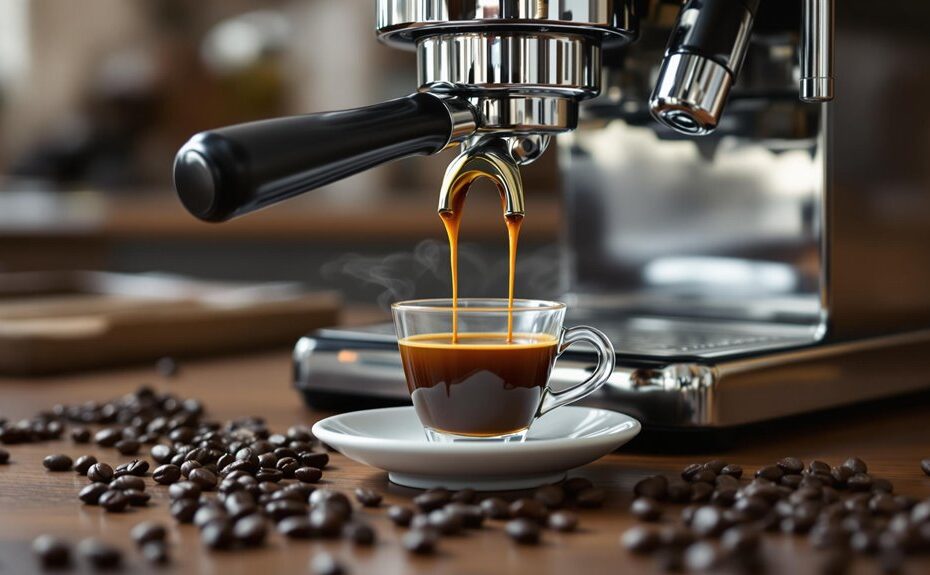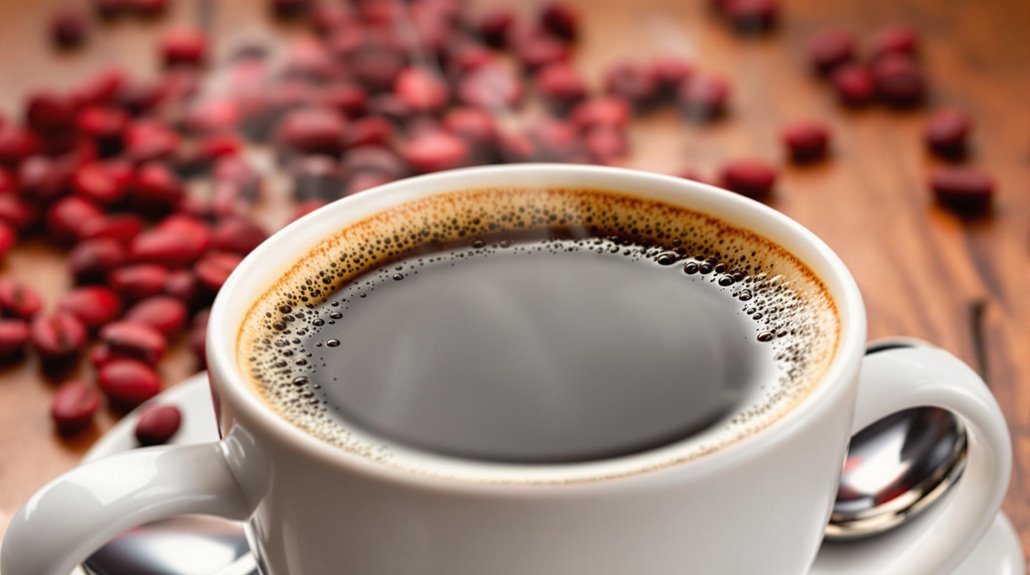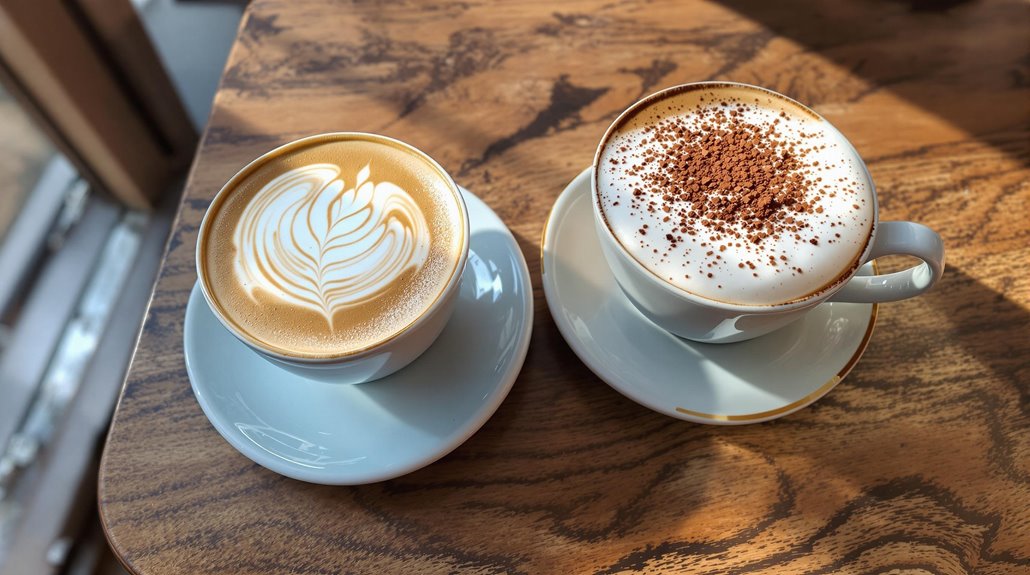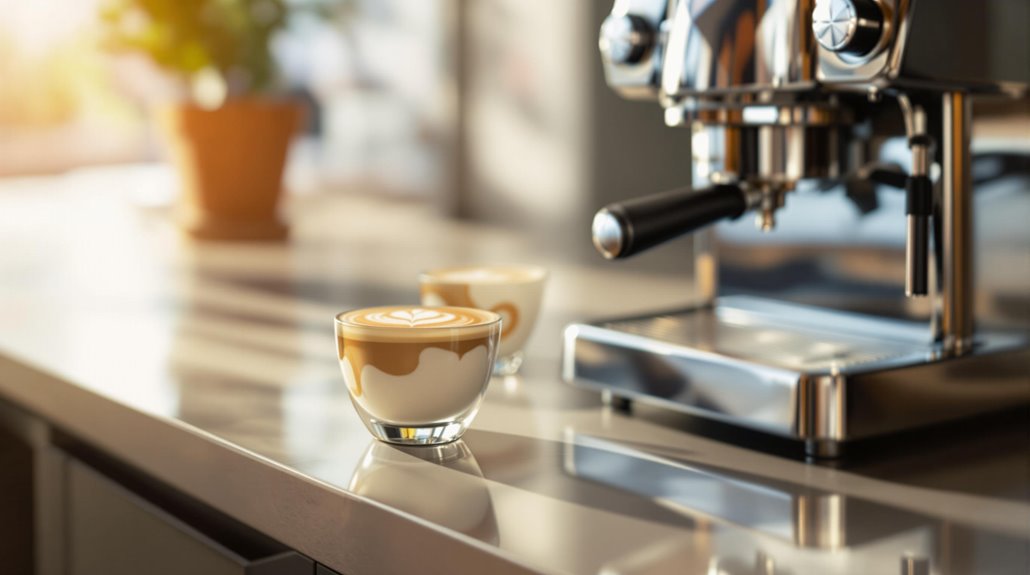







If you're looking to make a ristretto, you'll want to start by understanding the unique characteristics that set it apart from regular espresso. You'll need specific equipment and a precise approach to grinding your coffee beans, as well as techniques for tamping and extracting. Each step is vital in achieving that rich, concentrated flavor profile. But before you grab your portafilter, it's important to explore the nuances that can elevate your ristretto experience, inviting you to discover the secrets behind this exquisite brew.
Key Takeaways
- Use 14-18 grams of freshly roasted coffee, ground finely, to prepare for one ristretto shot.
- Tamp the coffee grounds with consistent pressure of about 30 pounds for an even extraction.
- Lock the portafilter into the espresso machine and start extraction, aiming for 15 seconds total brewing time.
- Monitor the flow to ensure extraction begins within 8-10 seconds for optimal flavor development.
- Aim for a final volume of 15-20 ml (0.5 to 0.7 fl. oz.) to achieve the perfect ristretto shot.
Understanding Ristretto
When you plunge into the world of coffee, understanding ristretto is essential for truly appreciating its unique character. Ristretto, which translates to "restricted" in Italian, is a short espresso shot made with half the water of a standard espresso. You use the same amount of coffee grounds as you would for a normale espresso, but the result is a concentrated 15 ml (0.5 oz) of liquid.
The brewing time for a ristretto is typically around 15 seconds, a process designed to capture a sweeter and more intense flavor profile while minimizing bitterness. The result is a fuller body and rich, syrupy texture that many describe as having warm honey-like flavors. This method highlights the intricate nuances of the coffee, emphasizing individual taste preferences that are central to third wave coffee culture.
Equipment Needed
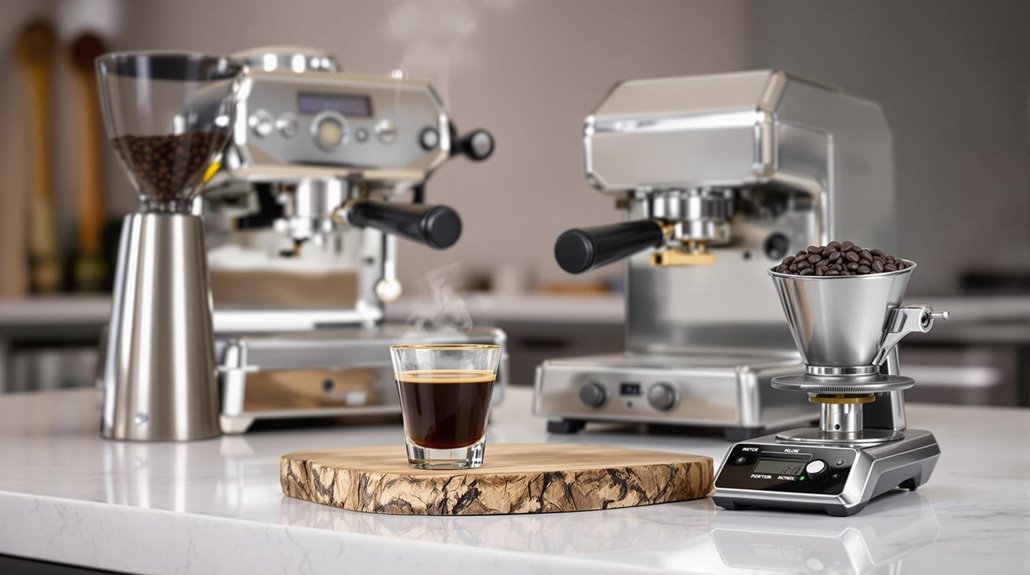
Crafting the perfect ristretto requires precision and the right tools. First and foremost, an espresso machine is vital. It provides the necessary pressure for extraction, allowing you to create that concentrated flavor profile that defines a ristretto. Look for a machine capable of delivering around 9 bars of pressure to guarantee peak results.
Next, a high-quality coffee grinder is important. The grind size directly affects the extraction, so you want to make certain you're using freshly ground beans. A burr grinder is preferable, as it'll give you a consistent grind, vital for achieving the right balance of flavors.
When it comes to the amount of coffee, you're aiming for one espresso shot but extracted with half the water. This means you'll typically need about 14-18 grams of coffee to produce a ristretto shot that measures 15-20ml (0.5 to 0.7 fl. oz).
Finally, don't forget about serving. A small glass or demitasse is ideal for presenting your ristretto. Regular maintenance of your equipment will guarantee consistent performance, making your journey to the perfect ristretto smooth and enjoyable.
Grinding Coffee Beans

Grinding coffee beans is an important step in achieving the rich, concentrated flavor that defines a perfect ristretto. To get the most out of your coffee, you should grind your beans just before brewing, using freshly roasted ones for ideal flavor preservation. Aim for a fine grind, typically using 7–10 grams of coffee for each ristretto shot. This finer consistency enhances the extraction of flavors, creating that bold profile you're after.
Using a high-quality coffee grinder is vital. A consistent grind size guarantees even extraction, which directly impacts the quality of your ristretto. Remember, the grind for ristretto should be finer than what you'd use for standard espresso, intensifying the flavor concentration.
While grinding, pay attention to the tamping pressure you'll apply later. A firmer tamp can help compact the coffee grounds, contributing to a richer, more flavorful ristretto. By focusing on these details during the grinding process, you're setting the stage for a truly exceptional shot. So, take your time, enjoy the process, and relish the journey to crafting the perfect ristretto.
Tamping Techniques
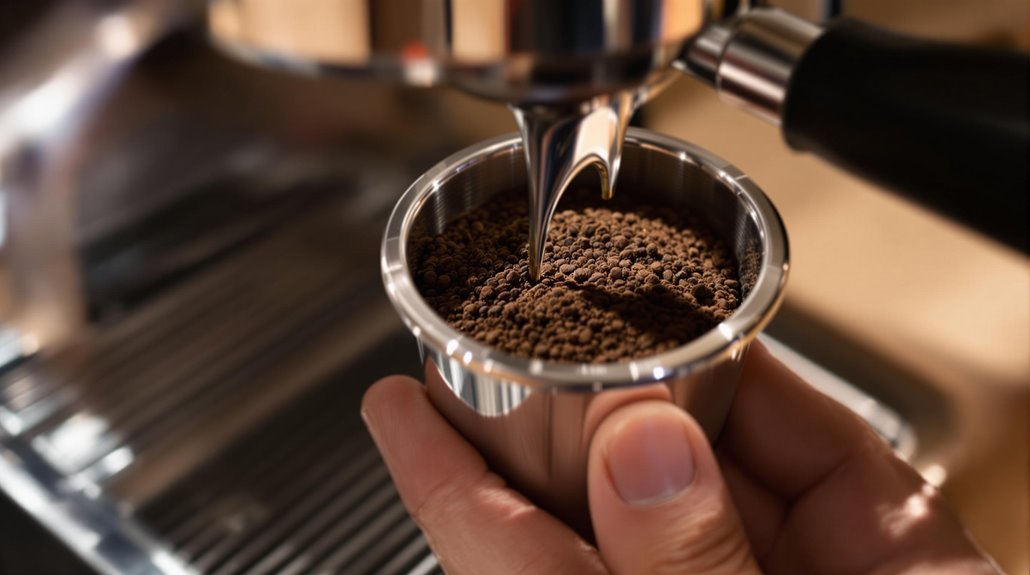
When you're tamping, consistent pressure is key to achieving an even extraction, so aim for about 30 pounds of force. Using a flat tamper helps create a uniform surface, ensuring that water flows evenly through the grounds. Don't forget to give the portafilter gentle taps afterward to settle the coffee and eliminate air pockets for the best results.
Importance of Even Pressure
Even pressure during tamping plays a pivotal role in the extraction process of a ristretto, greatly influencing the shot's overall quality. When you tamp to guarantee consistent tamping pressure, you create a compact coffee puck that allows for ideal water flow during extraction. If the tamping is uneven, it can lead to channeling, resulting in inconsistent flavor profiles that diminish the integrity of your ristretto.
Aim for a tamping pressure of about 30 pounds (13.6 kg). This level of pressure helps create an even surface that supports uniform extraction. Remember, your motion should be firm and steady; avoid twisting or rocking the tamper, as this can compromise the integrity of the coffee grounds.
After tamping, consider using a tool like the Razor to check that your coffee dose is accurate and the puck is level. This step further promotes even extraction, enhancing the flavor and richness of your ristretto. Practicing consistent tamping techniques not only improves your ristretto but also hones your skills for crafting various espresso-based drinks. Keep refining your approach, and you'll notice the difference in every cup you make.
Tamping Tools and Techniques
Achieving the perfect ristretto hinges on mastering your tamping tools and techniques. To start, you'll want a level tamper that allows you to create a flat coffee bed. This uniform surface is essential for even extraction and prevents channeling, which can ruin your shot. Apply consistent pressure, typically around 30 pounds, to guarantee effective tamping and maximize the extraction of coffee solids.
Before you tamp, give your portafilter a few gentle taps. This technique helps settle the grounds, eliminating air pockets, and prepares them for compression. A fine grind size is important, as it increases the surface area for extraction, intensifying your ristretto's flavor.
After tamping, consider using a Razor tool to check dose accuracy. This confirms you've used the correct amount of coffee, which is critical for achieving that rich, concentrated taste you're after. Remember, the right combination of tools and techniques not only enhances your brewing process but also elevates the quality of your ristretto. With practice, you'll master these techniques, allowing you to enjoy a perfectly crafted cup every time.
Extracting the Espresso
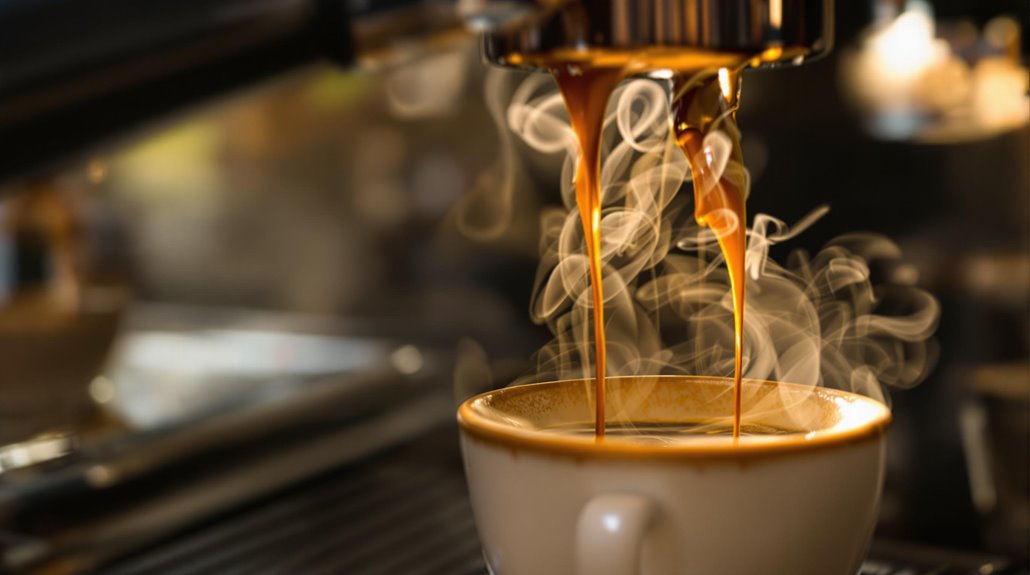
To extract the perfect espresso, securely place the portafilter in the group head of your machine, ensuring a tight seal for ideal pressure. Once you've got your cups positioned beneath the spouts, press the two-cup button to start the brewing process. Keep a close eye on the extraction time; you want that rich espresso to flow within 8-10 seconds for the best flavor profile.
Portafilter Placement Technique
Properly placing the portafilter is essential for a successful ristretto extraction. Start by verifying your portafilter is clean and dry; any residual moisture can interfere with the extraction process. Next, align the portafilter with the notch in the group head, and turn it clockwise until it locks into place. This tight seal is critical, as it guarantees that water flows evenly through the coffee grounds.
Before you begin extraction, double-check that your cups or serving glasses are positioned beneath the portafilter to catch the espresso as it flows out. This attention to detail prevents messy spills and confirms you capture every drop of that rich ristretto.
Activate your espresso machine by pressing the two-cup button, which initiates the flow of water through the coffee grounds in the portafilter. As you monitor the extraction, keep an eye on the clock; the espresso should start to flow within 8-10 seconds. This timing is essential for achieving that smooth, concentrated shot you're after. With precise portafilter placement and attention to these steps, you're well on your way to crafting the perfect ristretto.
Extraction Timing Importance
While every aspect of the ristretto preparation matters, extraction timing stands out as a key factor in producing that perfect shot. For a ristretto, you should aim for an extraction time of about 15 seconds, noticeably shorter than the standard espresso's 25-30 seconds. This shorter shot captures the sweeter and more aromatic compounds from the coffee grounds, while minimizing bitterness.
Proper timing is essential; if you cut the extraction too early, you risk under-extraction, resulting in a sour taste. Conversely, extending the extraction leads to over-extraction and unwanted bitterness. During coffee brewing, you need to closely monitor the flow of espresso. Ideally, it should start flowing within 8-10 seconds, marking the sweet spot for flavor development.
You're using the same amount of coffee grounds as a full espresso shot but with only 15-20 ml of water, intensifying the flavor profile. Precision in extraction timing not only influences taste but also enhances your overall coffee experience. Remember, mastering this aspect can elevate your ristretto from good to exceptional, ensuring you savor each sip.
Making the Ristretto

Achieving the perfect ristretto requires precision and attention to detail at every step. Start by grinding 7-10 grams of freshly roasted coffee beans to a fine consistency. This grind size is vital for making a ristretto shot, as it influences the extraction process and flavor. Next, level and tamp the coffee grounds firmly in the portafilter to guarantee an even extraction, which is essential for that syrupy texture typical of ristretto coffee.
Once the grounds are tamped down, lock the portafilter into your espresso machine. Begin the extraction process, aiming for a brewing time of about 15 seconds. Keep a close eye on the flow; you want approximately 15-20 ml (0.5 to 0.7 fl. oz.) of espresso to pour. This volume is characteristic of a ristretto shot, delivering a concentrated burst of flavor.
After the extraction, your final ristretto should exhibit a rich, dark-brown color topped with a thick crema. This visual cue indicates a successful pull, promising a bold and intense coffee experience. Follow these steps closely, and you'll master the art of making a perfect ristretto.
Flavor Profile and Characteristics

The ristretto shot stands out not just for its preparation but also for its unique flavor profile and characteristics. When you brew a ristretto, you'll notice a bright, sweeter flavor that sets it apart from traditional espresso. The restricted extraction time and reduced water content, usually around 15 seconds, minimize bitterness while enhancing sweet and fruity notes. This results in a syrupy texture, reminiscent of warm honey, delivering a rich and intense coffee experience.
Using the same amount of coffee grounds as a standard espresso shot, a ristretto typically yields about 15 ml (0.5 fl. oz.). This smaller volume concentrates the flavors, making every sip bold and impactful. While some may perceive ristretto as one-dimensional compared to espresso's complexity, it still caters to those who crave an intense coffee experience.
Ultimately, understanding ristretto needs is essential for appreciating its unique profile. The balance of sweetness and low bitterness creates a delightful contrast, making ristretto a compelling choice for coffee enthusiasts who enjoy exploring different flavor nuances. With its distinctive attributes, the ristretto is not just a shot; it's a flavorful journey.
Differences From Espresso
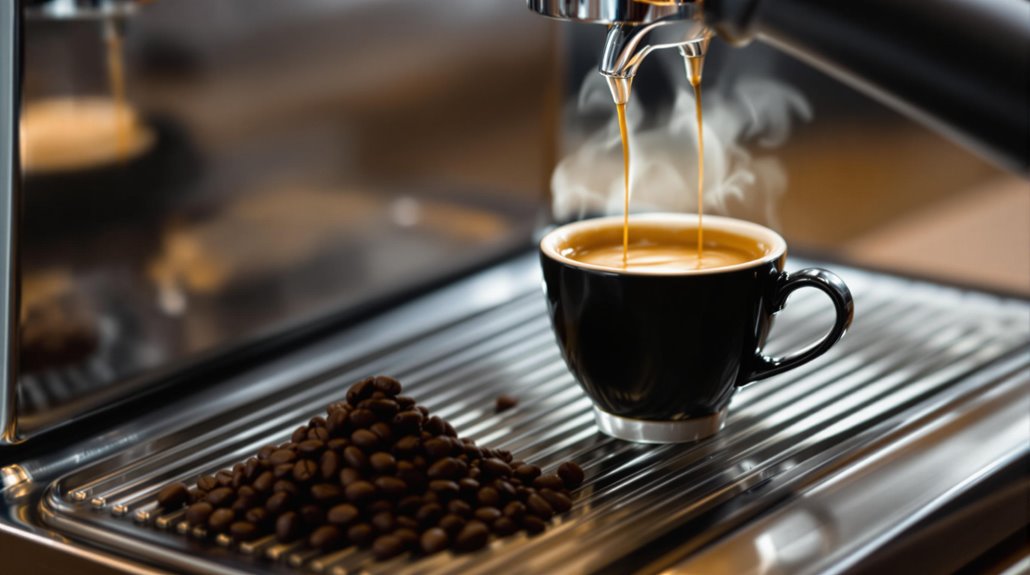
When comparing ristretto to espresso, you'll quickly notice key differences that define their unique identities. A ristretto shot measures approximately 15 mL (0.5 fl. oz.), while a standard espresso shot is around 30 mL (1 fl. oz.). Both use the same amount of coffee grounds, but ristretto requires less water, resulting in a more concentrated flavor.
The extraction time for ristretto is about 15 seconds, notably shorter than the 25-30 seconds typically needed for espresso. This shorter extraction period means ristretto captures the sweet, fruity notes of the coffee while minimizing the extraction of bitter compounds. As a result, ristretto is characterized by a sweeter, less bitter flavor profile, whereas espresso can present a broader range of complex flavors, often accompanied by pronounced bitterness.
These differences in volume, water usage, and extraction time highlight how ristretto espresso offers a unique experience, appealing to those who prefer a more concentrated and sweeter taste. If you're seeking to explore the nuances of coffee, understanding these distinctions is essential for appreciating each brew's distinct qualities.
Ristretto Variations

Exploring ristretto variations opens up a world of flavor possibilities that can enhance your coffee experience. One popular option is the Piccolo Latte, crafted using two shots of ristretto combined with steamed milk in a 1:1 ratio. This espresso drink is typically served in a Gibraltar glass, providing a creamy texture that amplifies the rich notes of the ristretto.
If you're in the mood for something invigorating, try an Iced Ristretto. Start by preparing two shots of ristretto, mixing them with frothed milk, and add ice only at the end to prevent dilution. This guarantees your drink retains its robust flavor.
Don't forget about flavor enhancements! Incorporating flavored syrups like caramel or vanilla can elevate the sweetness and overall taste profile of your coffee drink. Additionally, adjusting the grind size and tamping pressure while brewing your ristretto can greatly impact the flavor intensity and aroma, allowing for a personalized coffee experience.
Nutritionally, variations like the Piccolo Latte contain approximately 45 kcal per serving, with additional calories from milk and any added sugar. Experimenting with ristretto variations lets you discover new favorites tailored to your palate.
Serving Suggestions

When serving your ristretto, consider pairing it with pastries like almond croissants or biscotti to elevate the experience, as their textures and flavors beautifully complement the coffee's intensity. If you prefer a creamier option, enhancing your ristretto with steamed milk in a piccolo latte creates a delightful balance of rich and bold flavors. Each pairing offers a unique twist, allowing you to explore the versatility of ristretto in your coffee routine.
Pairing With Pastries
To truly elevate your ristretto experience, consider pairing it with a selection of pastries that enhance its rich and complex flavor profile. The syrupy richness of a ristretto shot complements buttery pastries like croissants, accentuating their flaky texture and subtle sweetness. When you choose chocolate-based pastries, such as éclairs or chocolate croissants, the concentrated sweetness of the ristretto perfectly balances the chocolate's richness, creating a decadent treat.
Fruit-based pastries, like tarts or Danish pastries, also shine when served alongside ristretto. The coffee's fruity notes harmonize beautifully with the natural sweetness of the fruit, resulting in a delightful contrast. If you're in the mood for something nutty, pastries like almond croissants or hazelnut biscotti enhance the nutty flavors while the intensity of the ristretto cuts through the sweetness.
For a refined touch, a small serving of biscotti or a delicate macaroon pairs wonderfully with your ristretto shot. This combination allows you to enjoy a delightful interplay of textures and flavors in each sip and bite. Next time you visit your favorite coffee shop, remember these pairing suggestions for an elevated ristretto experience!
Enhancing Milk-Based Drinks
Pairing your ristretto with pastries is just one way to enjoy this concentrated coffee, but enhancing milk-based drinks can take your experience to another level. One excellent option is a piccolo latte, created with two shots of ristretto and equal parts steamed milk. This combination delivers a rich, creamy texture while preserving the intense coffee flavors you crave.
If you're looking for something invigorating, try an iced ristretto. Simply prepare two shots of ristretto, mix them with frothed chilled milk, and serve over ice. This method keeps the flavor intact without dilution, making it a perfect summer treat.
Ristretto shots can also elevate lattes and cappuccinos, intensifying the coffee flavor when mixed with textured milk. For a unique twist, consider adding flavored syrups like caramel or vanilla. These enhancements not only complement the syrupy sweetness of the ristretto but also create a more complex flavor profile.
Keep in mind that the sugar content from added ingredients, like milk and syrups, can affect the overall caloric content of your drink. So, balance your choices wisely to enjoy the best of your ristretto experience.
Disclosure: As an Amazon Associate, I earn from qualifying purchases.
